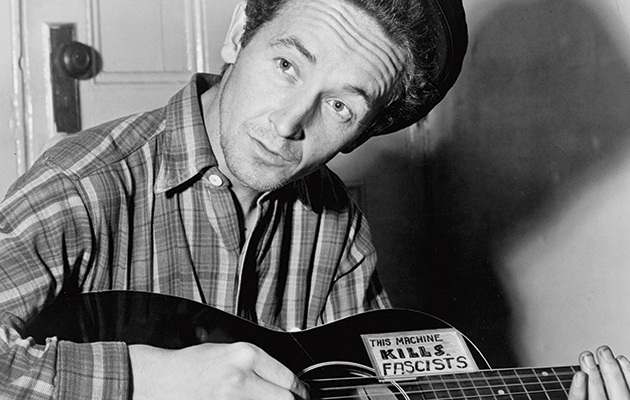Woody wrote his most famous tune in 1941, after an arduous cross-country trip. He drove from LA to Pampa, Texas, where his family lived. Then he took a bus to Pittsburgh, hitchhiking the rest of the way to NYC. There, at a hotel called Hanover House on West 43rd Street he reflected on his month-long journey and wrote “This Land Is Your Land”, one of the most popular American songs of the 20th century and, as Ani DiFranco says, “an unofficial national anthem”. It’s a song taught in schools, one of those tunes that seeps into the ether of the nation’s everyday life.
Woody scrawled the verses in an old notebook, one of many filled with songs he recorded and others he never set to tape. At the bottom of that particular page he scribbled a simple phrase that amounts to a complex mission statement, one that sums up his own musical enterprise and inspires others since: “All you can write is what you see.” Songs, in other words, were to him a means of reporting the news, of summing up the times, of gauging the temperature of the nation, of chronicling your own life. It’s a truism, but also a challenge to himself and to others.
In other words Woody doesn’t demand followers. Rather, his music encourages his listeners to be their best and truest selves, to do good and honourable work in whatever form suits them. In that regard some of the albums truest to Woody’s spirit sound very little like him. Alynda Segarra literally followed in Woody’s footsteps: a teenage runaway turned vagabond musician, she hitchhiked and hopped trains across America in the 2000s, then started busking to earn money to move along to the next town, opening herself up to the nation’s landscape and its people along the way. “Woody didn’t know he was instilling a sense of patriotism in this Puerto Rican girl from New York, this sense that America belongs to me, too.” Segarra admits she found her truest expression in the latest Hurray For The Riff Raff album, The Navigator, on which she adopts a fictional persona to tell a story that mixes autobiography and science-fiction. “With that album it feels like I’ve finally figured out how to be me. It’s based off of a character, with a whole story to the album. It felt like I had to try on a lot of different personas. I had to go out and experience the country. I had get far away from where I came from in order to say: ‘OK, it’s time to be me now.’ I learned that lesson from Woody. It got in me and I can’t get it out now.”
If you know about Guthrie in the 21st century, it’s likely due to the efforts of Nora Guthrie, who serves as president of Woody Guthrie Publications. She admits she’s an unusual choice to tend her father’s legacy. She’s not a musician and certainly not a folk singer. Woody’s youngest child, she never learned to play guitar, never wrote songs or sang them for people. Instead, she studied dance. “I’m the last of all the children and the only female in the group,” she says. “I’m the only one who doesn’t play guitar. When all this started happening, I would look up and say, ‘Dad, why me? What do I know about folk music?’”
But she feels she was chosen to do expand his legacy, and she has undertaken the enterprise creatively, working diligently to show every side of her complicated father. She has spent the last 30 years spearheading projects in different media: a new symphonic interpretation of “This Land Is Your Land” by composer David Amram, a collection of Woody’s songs about Jewish culture arranged by the Klezmatics, a book of his artwork, even a walking tour of New York City. She has also given his unrecorded sets of lyrics to other artists so they might add melodies, arrange and record them, and give the world new Woody songs. Perhaps the most famous entries in this new canon have been the Mermaid Avenue trilogy of records made by Wilco and Billy Bragg – for a certain generation, Jeff Tweedy’s version of “California Stars” may be the most popular Woody Guthrie song, right up there with “This Land Is Your Land”.
Her inexhaustible efforts have dramatically changed how we view Woody Guthrie in the 21st century, while providing a model for how such multi-faceted artists might be presented to new generations with no firsthand knowledge of them. In 2013 his archives were moved to the Woody Guthrie Center in Tulsa, which has a permanent display of his letters, lyrics, paintings, drawings, wood carvings, and musical instruments. “It’s difficult keeping up with him. He put out so much in a very short time. There’s no end in sight that I can see. It won’t be me who will do it all.”
Perhaps it will be Anna Canoni, billed somewhat modestly as senior operations manager for Woody Guthrie Publications. “So much of my family has been up onstage, so it’s nice to work behind the curtain,” she says. “Woody’s voice has such integrity to it that it deserves to be available and accessible. It’s a family responsibility, but it’s even bigger than that. I can’t fail society by not keeping him alive.”



